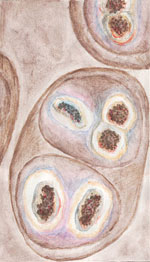Copper Ions Keep Roofs Clean
Homeowners spend lots of time and money keeping insects, rodents and other assorted vermin at bay and out of their houses. But one familiar pest - Gloeocapsa magma- does its dirty work outside the home, up on the roof. Gloeocapsa is an airborne algae with a taste for limestone, a common component of asphalt roof shingles. The by-product of this unique appetite is ugly black streaks that can build up and completely discolor a roof in just a few years. One way homeowners are meeting this challenge is through the use of asphalt shingles containing algae-resistant copper roofing granules.
According to Frank Stilley, president and owner of Amstill Corporation, a Houston-based contracting firm, "Many homeowners are more likely to replace a badly streaked roof than clean it, even if the roof hasn't reached its full service life." Shingle manufacturers estimate that approximately 80 percent of all roof replacements are caused by this pest. Gloeocapsa can end up costing homeowners thousands of dollars they may not need to spend.
WHEN ALGAE ATTACK
 Asphalt shingles contained with the algae
Asphalt shingles contained with the algaeHow does Gloeocapsa infect a roof? Typically, reproductive spores are blown there by the wind. Birds, squirrels and other small animals also act as spore carriers. Algae prosper where nutrients, moisture and heat are present, and a sun-warmed, rain-dampened asphalt roof is a perfect host environment. In addition, the porous limestone on shingles absorbs moisture, encouraging growth. Once a colony establishes itself, the algae form a dark, protective covering to shield it from the sun's ultraviolet rays. The black streaks that appear are actually multiple layers of dead algae cells that build up over time.
Many people consider Gloeocapsa to be only an aesthetic issue. However, prolonged contamination can affect a roof's longevity. Limestone granules provide a protective barrier atop the shingles. As the algae consume the limestone, this barrier diminishes, creating a risk of premature shingle failure. Gloeocapsa also absorbs heat, causing roof surface temperatures to rise. A hotter roof means a greater load on the air-conditioning system and higher costs to cool the home.
COPPER SAVES THE DAY
One way homeowners are meeting this challenge is through the use of asphalt shingles containing algae-resistant copper granules. Copper's ability to resist and even destroy harmful organisms is well known. Since ancient times, people have stored drinking water in copper vessels to prevent disease, while marine biologists today rely on metallic copper sulfate to treat and kill algae blooms. Current research into copper's biocidal properties indicates it could provide a practical way to help control the cross-contamination of antibiotic-resistant microbes.
Asphalt roof shingles with copper-oxide ions entered the marketplace a decade ago. Moisture slowly leaches these oxides out of porous ceramic granules, forming a layer of algae-killing copper over the shingles. Depending on the product, this continual leaching process can protect a roof from algae for up to 30 years.
Most asphalt shingle manufacturers offer algae-resistant products in a variety of colors and sizes. While initially more expensive, they help maintain a roof's visual appeal and aesthetic value and may offset the cost of cleaning a roof every few years, which averages $500 for a single-family home.
Proponents believe it is just a matter of time before copper-granule shingles become the industry standard for homebuilders in areas where Gloeocapsa is a problem. According to Amstill's Frank Stilley, "Contractors are realizing that they can benefit the consumer by making algae-resistant shingles standard on their homes, rather than an upgrade option." Cu
Also in this Issue:
- Got Copper (In Your Diet)?
- Copper Ions Keep Roofs Clean
- Heating and Cooling "Green" With Copper
- A Copper Dollar in Your Pocket
- Building Better Bridges

 Gloeocapsa magma
Gloeocapsa magma